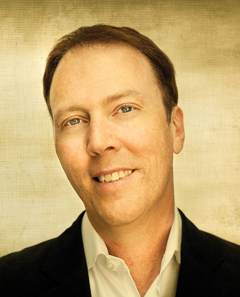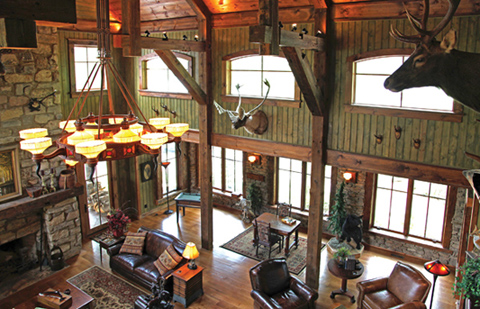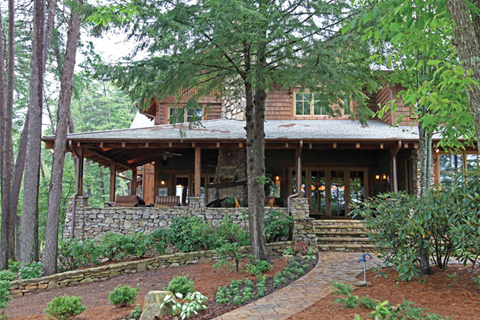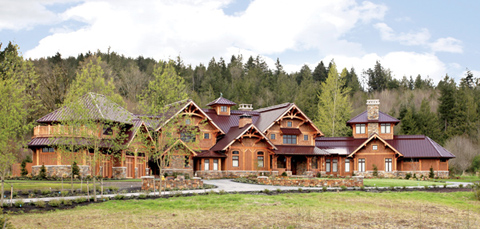Allen Halcomb began his architectural design career in 1983. Based in Knoxville, Tennessee, he works from East Coast to West, as well as internationally. His specialty is working with log, timber, stone, and other natural elements to create classic, timeless designs.
If there is one principle his firm, MossCreek Designs, was founded on, and which continues today, it is a dedication to the design of rustic-style homes. Be it a design based on local history and tradition, or a new style altogether, the common thread of Halcomb’s architectural design is creating a sense of connectedness to the surrounding environment.
 Your designs are very innovative, but harken to a bygone era when homes were built using only the available local materials. Is this something that you deliberately strive to achieve with homes you design all across the country?
Your designs are very innovative, but harken to a bygone era when homes were built using only the available local materials. Is this something that you deliberately strive to achieve with homes you design all across the country?
We definitely look to see what is the historical regional style for the area; we feel it needs to be understood. From there we determine how we might want to vary, if at all, from that historical regional style. Some of our clients want a significant shift from historical designs, and we are able to do modern interpretations of historical styles. The ultimate goal, and reason for looking back toward tradition, is to create a home that looks like it has roots in the area.
If there is a simple term to describe your signature style, what would that be?
It’s a question I’ve been asked before, and each time I offer a new phrase that I think describes us perfectly, someone else trademarks it! So … let me try this new word, “pastiche.” That is truly what our work is. The appropriate definition being: “Borrowing from various other aesthetic art forms in order to create a new composition.” Our signature style, in simple English, is a comfortable and pleasurable arrangement of historic architectural elements and reclaimed and natural materials. We import a variety of historic building techniques from all over the country and blend them into a hybrid version that feels appropriate for each client.
Speaking of reclaimed and natural materials,”what is the MossCreek Elements part of your business all about?
MossCreek Elements evolved from the challenging task of finding the interesting materials we spec for the homes we design. We strive to use materials that couldn’t possibly be purchased at a big box store … which presents a builder with the challenge of sourcing the stuff. Over many years, we’ve established relationships with a multitude of unique material vendors and put together a collection of building materials such as mushroom board, antique timbers, wormy chestnut , poplar bark shingles, and reclaimed barn wood flooring. We introduce these vendors, largely for the resource benefit to the builder, but also because we know they will deliver a product that is up to our specifications. The collaboration has been very successful. We don’t make a profit off the vendors’ sales, but in the long run it helps us business wise because our homes can be built in the way they were intended. The vendors respond very positively to the exposure we offer them through MossCreek Elements, making sure our clients receive attention and great service, which helps to advance their niche product into the larger market. It’s a beneficial arrangement all the way around.

Do you get many requests from clients to incorporate more modern, “edgier,” materials in your designs, rather than the natural materials you typically spec?
I wouldn’t say “many” just yet, but it is a trend that we have noticed and are excited about. Even though we specialize in a historical design style, we are aware that design and materials evolve, just as peoples’ tastes do. Great design shouldn’t be “exclusive” in any way, and certainly not in material selection. A nice blending of old and new can increase the appeal and excitement of a design. Our goal has always been to create the perfect design that reflects our client’s desires, while remaining true to the style that first attracted that client to us.
Do you find yourself wanting to dabble in something other than what you have been doing for so many years?
What excites me about switching gears with materials are the challenges that arise in the experience. Challenge engages our creative senses. I relish the chance to work with more modern materials but, because we are established in the rustic design realm, we’ve had limited requests to do so. I live in a remodeled timber frame warehouse in downtown Knoxville, so that has satisfied some of my desire to venture “outside of the box.” Bottom line, though, I believe that when a client comes to you and sets down a set of design parameters, whether it is rustic or modern, log or metal, the challenge is to embrace the job you have been given and create something wonderful with it. So there is always the opportunity to be excited.

Are you finding that your new clients are more budget conscious than clients were, say, five years ago?
That is a nicely worded, and loaded, question! I will say that post-2008 something very interesting happened. Prior, we designed all kinds of rustic-style homes, small to large, for all sorts of clients, but after 2008 a certain type of project disappeared, and that would be the type of trophy home that was built on extended credit. What happened afterward was that things settled down for about a year, and then a different type of client came out of the forest fire—a client with a more reserved approach to life in general, which is why they were still able to afford to build a home. Right now we are designing a substantial volume of homes that are 2,500 to 3,500 square feet. The designs are not driven by “how much can we spend?” but rather “how much do we care to spend?” We are also still designing homes in excess of $10 million, but even those clients are taking a reserved approach to how their project fits within their overall finances. There has been a change of heart, more toward cautiousness than extravagance. Who we are doing business with is a different type of client, or maybe the same type of client, but with a changed attitude.
You have already explained that there hasn’t been a major change in what clients are looking for from your firm, but what would you describe as the biggest shift in your designs over the years, and what has driven it?
In the 29 years that I have been designing homes I would say the last five years we have shifted into more hybrid designs. We are designing homes that use more conventional framing with log and timber elements. A hybrid design offers more latitude for wiring and plumbing; it offers more flexibility with finishes. Again, I would say that the strongest trend that has evolved since 2008 is that homes seem to have a more conservative approach, even the larger homes seem to feature a little less flash and a little more intrinsic value. Our whole mixed materials concept has caught on fire, fortunately, and for us it is becoming quite normal.
Why is that fortunate for you … doesn’t that undermine your “specialness”?
Just like with any business, if you create something special and are successful, and people become aware of it, people will imitate what you do. You can curse that or you can relish the fact that your style is becoming one of the trending styles. I am okay with all of us succeeding. At the end of the day, we have accepted the fact that every five or six years we introduce something dramatic to the rustic market and it becomes normal. It keeps our surf board on top of the wave. We’ve become a reference point, a brand.

Do you contract with structural engineers for your clients’ final blueprints or do they handle that on their own, with referrals from you?
We offer three levels of service: stock plans, custom design, and full-service design. When we first entered the marketplace we found white space; at one end of the spectrum you would have draftsmen designing a home and at the other you would have salon architects who provide a tremendous amount of service on the high end of cost. What was missing in the market was a designer with a degree in architecture offering a limited amount of service for a cost that fell in between the existing offerings. In this middle level, we design a custom home for a client and then turn the project over to their builder. However, we are always available for support during the construction process. For most projects under 4,000 square feet, many of the details can be handled well at the construction level. When we get into larger homes, we also offer a full-service option. This can include selecting the interior finishes, lighting, all the engineering, and construction oversight services. This three-tiered practice has been consistent from the start of our business.
Commercial architecture in the USA seems to appear more and more homogenous. Being that your designs are so unique, do you ever receive commissions for designing commercial structures? How do you feel about that trend toward homogenous development?
 As far as trends go, it is the trend that I observe with the most melancholy. Imagine if everything in our country burned down and had to be rebuilt! It would all look the same! It’s unfortunate, but it is what it is. Most commercial work is so price driven, developers just can’t spend the money to do something particularly beautiful and wonderful. At MossCreek, we have degrees in architecture but we are not licensed architects, so we are not in the business of providing architectural services for commercial projects. What we do provide is consultation with developers to conceive a theme for their commercial enterprise. Then they take that concept to an architect and convey what they want it to look like. This accounts for probably 10 percent of our work. We are currently starting a project in Alberta that is a retirement living community designed with a lodge feel, 70 rooms with all high-end amenities, designed for folks who are retiring well and need just a little assistance. It is a highly themed, sort of ‘Tahoe style’ project. We are doing the initial theme drawings and then the architect will take over. In this scenario, we are effectively a set designer.
As far as trends go, it is the trend that I observe with the most melancholy. Imagine if everything in our country burned down and had to be rebuilt! It would all look the same! It’s unfortunate, but it is what it is. Most commercial work is so price driven, developers just can’t spend the money to do something particularly beautiful and wonderful. At MossCreek, we have degrees in architecture but we are not licensed architects, so we are not in the business of providing architectural services for commercial projects. What we do provide is consultation with developers to conceive a theme for their commercial enterprise. Then they take that concept to an architect and convey what they want it to look like. This accounts for probably 10 percent of our work. We are currently starting a project in Alberta that is a retirement living community designed with a lodge feel, 70 rooms with all high-end amenities, designed for folks who are retiring well and need just a little assistance. It is a highly themed, sort of ‘Tahoe style’ project. We are doing the initial theme drawings and then the architect will take over. In this scenario, we are effectively a set designer.
As you look back at your previous design experiences, and forward to your work down the road, what do you see as a constant in what you offer to your clients?
It is always the engagement with people that drives us, creating an architectural expression that comes from the DNA of our clients. When we meet with an owner we spend a day or two talking and sketching, and talking and sketching some more. Based on their biases, likes, and dislikes ,a design evolves that reflects who they are. Not many designers do it that way, but it makes us ecstatic when we finish up a day of brainstorming with a client, and friends will stop in. Our clients will often show them the sketches and walk them through the plans as if MossCreek were only a small part of the process. It is validating and rewarding that our clients are so intimately involved in the solution that they see it as a true expression of themselves. i
For more information on Allen Halcomb and the design services offered by MossCreek, visit their website at www.mosscreek.net or call 800-737-2166.

